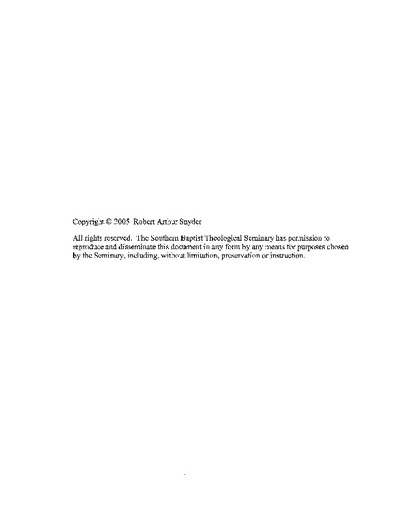| dc.contributor.advisor | Nettles, Thomas J. | |
| dc.contributor.author | Snyder, Robert Arthur | |
| dc.date.accessioned | 2009-12-10T21:05:13Z | |
| dc.date.available | 2009-12-10T21:05:13Z | |
| dc.date.created | 2005-06-28 | |
| dc.date.issued | 2005-06-28 | |
| dc.identifier.other | THESES Ph.D. .Sn92bw | |
| dc.identifier.uri | http://hdl.handle.net/10392/387 | |
| dc.description.abstract | This dissertation seeks to answer the question, what light does the ministry of William T. Brantly shed for understanding the breakup of the Triennial Convention? The dissertation argues that Brantly's longtime mission of uniting Christians in useful effort for a moral revolution exemplified the early vision of the Triennial Convention and that his inability as a Southerner to maintain this mission nationally among Baptists indicated grave disunity within the Convention as early as 1837.
After chapter I introduces Brantly in light of current historiography, the dissertation consists of three parts--early history, theology, and later history.
In the first part, encompassing the chapters 2 through 4, Brantly's personal mission is defined in the early South, illustrated in his first two Southern ministries, and climaxes in his efforts in Philadelphia. Two mentors and the death of his first wife influenced his personal mission. Two pastorates illustrated his twofold goal of organizing Baptists for missions and ministerial education. In Philadelphia, Brantly attained peace at First Baptist Church and then embodied his ideals in the formation of the Central Union Association.
The formation of this new association in contradistinction to the venerable Philadelphia Association raises the question of heresy in doctrine and innovation in practice. These concerns lead into the second part--a theological examination of Brantly's thought. Chapters 5 and 6 examine his views on Calvinism and the authority of Scripture. Chapters 7 and 8 explore his justification of revivalistic new measures and benevolent societies. Chapters 9 and 10 demonstrate that Brandy's idea of evangelical unity possessed a denominational identity, a doctrinal boundary, and an even greater emphasis on active benevolence.
The third part examines Brantly within the Triennial Convention. Chapter 11 discusses the Convention's transitional period (1826-1835), when sectionalism risked disunity, but compromise and silence nullified political strife and British interference. Chapters 12 and 13 examine the sectional and sectarian causes behind the visible disunity of the great Bible Convention of 1837. Brantly's stand for evangelical unity and subsequent defeat indicated grave disunity eight years before the Convention broke up. | en_US |
| dc.language.iso | en_US | en_US |
| dc.subject | Brantly, William T.--(William Theophilus),--1787-1845. | en_US |
| dc.subject | Baptist General Convention for Foreign Missions (U.S.) | en_US |
| dc.subject | Baptists--History. | en_US |
| dc.subject | Baptists--Missions--History. | en_US |
| dc.subject | Baptists--Government. | en_US |
| dc.subject | Slavery and the church--Baptists. | en_US |
| dc.title | William T. Brantly (1787-1845): A Southern unionist and the breakup of the Triennial Convention | en_US |
| dc.type | Thesis | en_US |
| dc.publisher.institution | Southern Baptist Theological Seminary | en_US |

